A Detailed Report on Australia's Mandatory Detention Policy
VerifiedAdded on 2022/11/17
|7
|2049
|285
Report
AI Summary
This report provides a comprehensive analysis of Australia's mandatory detention policy, focusing on its historical development, key legislations, and the rationale behind its implementation. The report details the Immigration Detention Remand, school detention, and indefinite detention policies, and traces their evolution through different government administrations, starting from the Keating government and extending through the Howard, Rudd, Gillard, Abbott, and Turnbull governments. It examines the impact of the Migration Act of 1958, the Pacific Solution, and the controversies surrounding child detention. The report identifies key issues, including the rationale and criticism of detention policies, guidelines from the United Nations High Commissioner for Refugees, and comparisons with practices in other major immigration countries. It also highlights cases of wrongful detention and the challenges posed by these policies. The report concludes by summarizing the key findings and implications of Australia's mandatory detention policy.
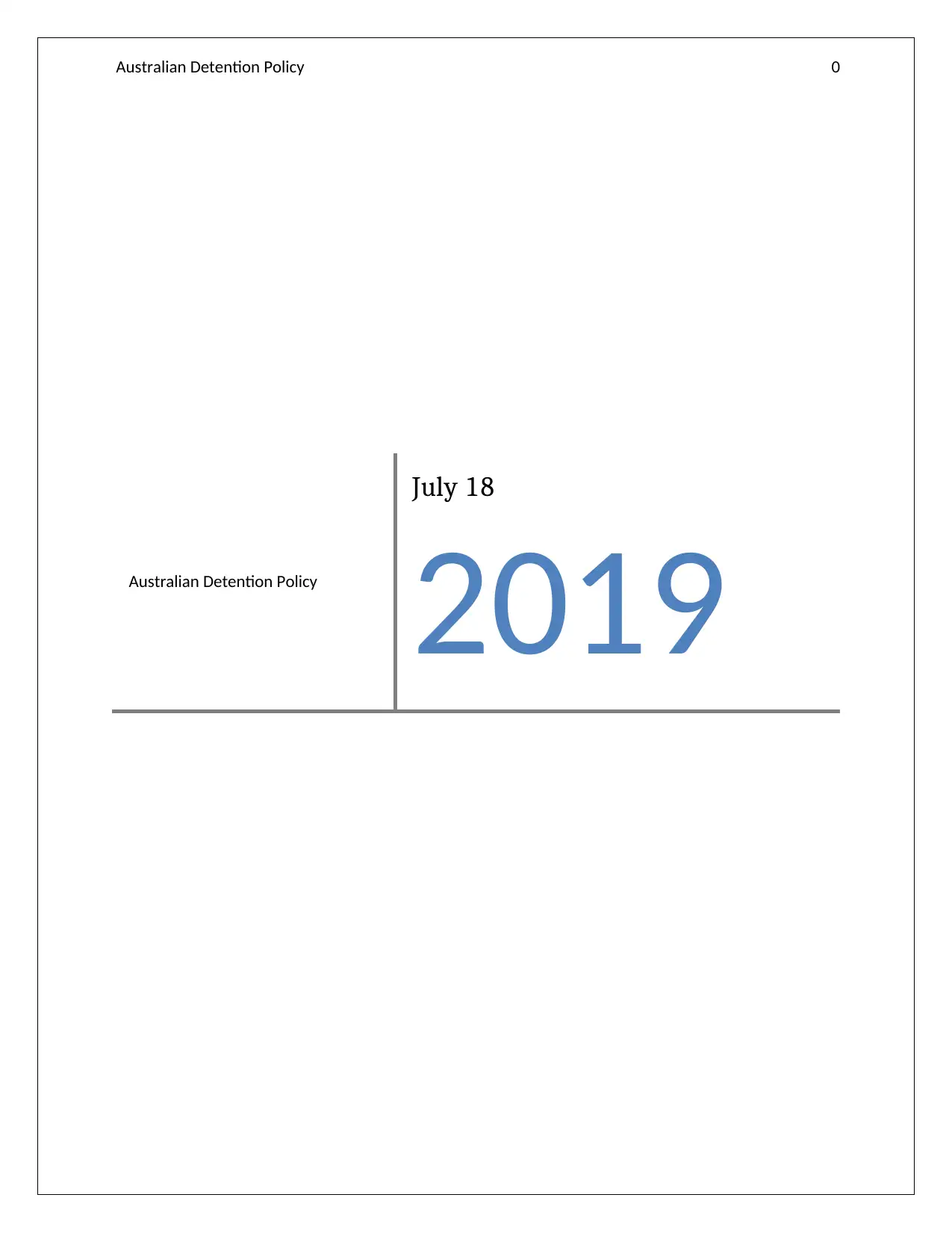
Australian Detention Policy 0
Australian Detention Policy
July 18
2019
Australian Detention Policy
July 18
2019
Paraphrase This Document
Need a fresh take? Get an instant paraphrase of this document with our AI Paraphraser
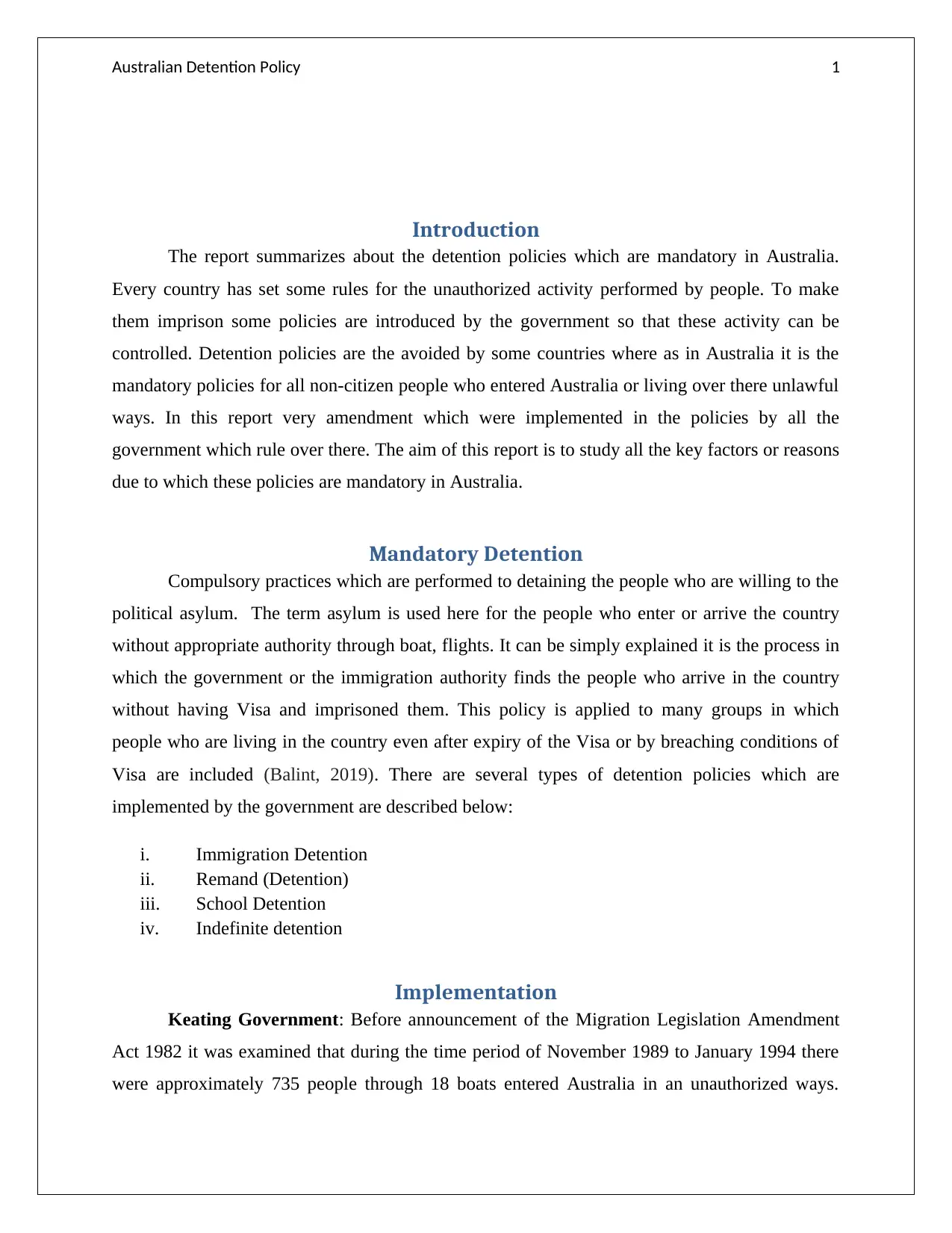
Australian Detention Policy 1
Introduction
The report summarizes about the detention policies which are mandatory in Australia.
Every country has set some rules for the unauthorized activity performed by people. To make
them imprison some policies are introduced by the government so that these activity can be
controlled. Detention policies are the avoided by some countries where as in Australia it is the
mandatory policies for all non-citizen people who entered Australia or living over there unlawful
ways. In this report very amendment which were implemented in the policies by all the
government which rule over there. The aim of this report is to study all the key factors or reasons
due to which these policies are mandatory in Australia.
Mandatory Detention
Compulsory practices which are performed to detaining the people who are willing to the
political asylum. The term asylum is used here for the people who enter or arrive the country
without appropriate authority through boat, flights. It can be simply explained it is the process in
which the government or the immigration authority finds the people who arrive in the country
without having Visa and imprisoned them. This policy is applied to many groups in which
people who are living in the country even after expiry of the Visa or by breaching conditions of
Visa are included (Balint, 2019). There are several types of detention policies which are
implemented by the government are described below:
i. Immigration Detention
ii. Remand (Detention)
iii. School Detention
iv. Indefinite detention
Implementation
Keating Government: Before announcement of the Migration Legislation Amendment
Act 1982 it was examined that during the time period of November 1989 to January 1994 there
were approximately 735 people through 18 boats entered Australia in an unauthorized ways.
Introduction
The report summarizes about the detention policies which are mandatory in Australia.
Every country has set some rules for the unauthorized activity performed by people. To make
them imprison some policies are introduced by the government so that these activity can be
controlled. Detention policies are the avoided by some countries where as in Australia it is the
mandatory policies for all non-citizen people who entered Australia or living over there unlawful
ways. In this report very amendment which were implemented in the policies by all the
government which rule over there. The aim of this report is to study all the key factors or reasons
due to which these policies are mandatory in Australia.
Mandatory Detention
Compulsory practices which are performed to detaining the people who are willing to the
political asylum. The term asylum is used here for the people who enter or arrive the country
without appropriate authority through boat, flights. It can be simply explained it is the process in
which the government or the immigration authority finds the people who arrive in the country
without having Visa and imprisoned them. This policy is applied to many groups in which
people who are living in the country even after expiry of the Visa or by breaching conditions of
Visa are included (Balint, 2019). There are several types of detention policies which are
implemented by the government are described below:
i. Immigration Detention
ii. Remand (Detention)
iii. School Detention
iv. Indefinite detention
Implementation
Keating Government: Before announcement of the Migration Legislation Amendment
Act 1982 it was examined that during the time period of November 1989 to January 1994 there
were approximately 735 people through 18 boats entered Australia in an unauthorized ways.
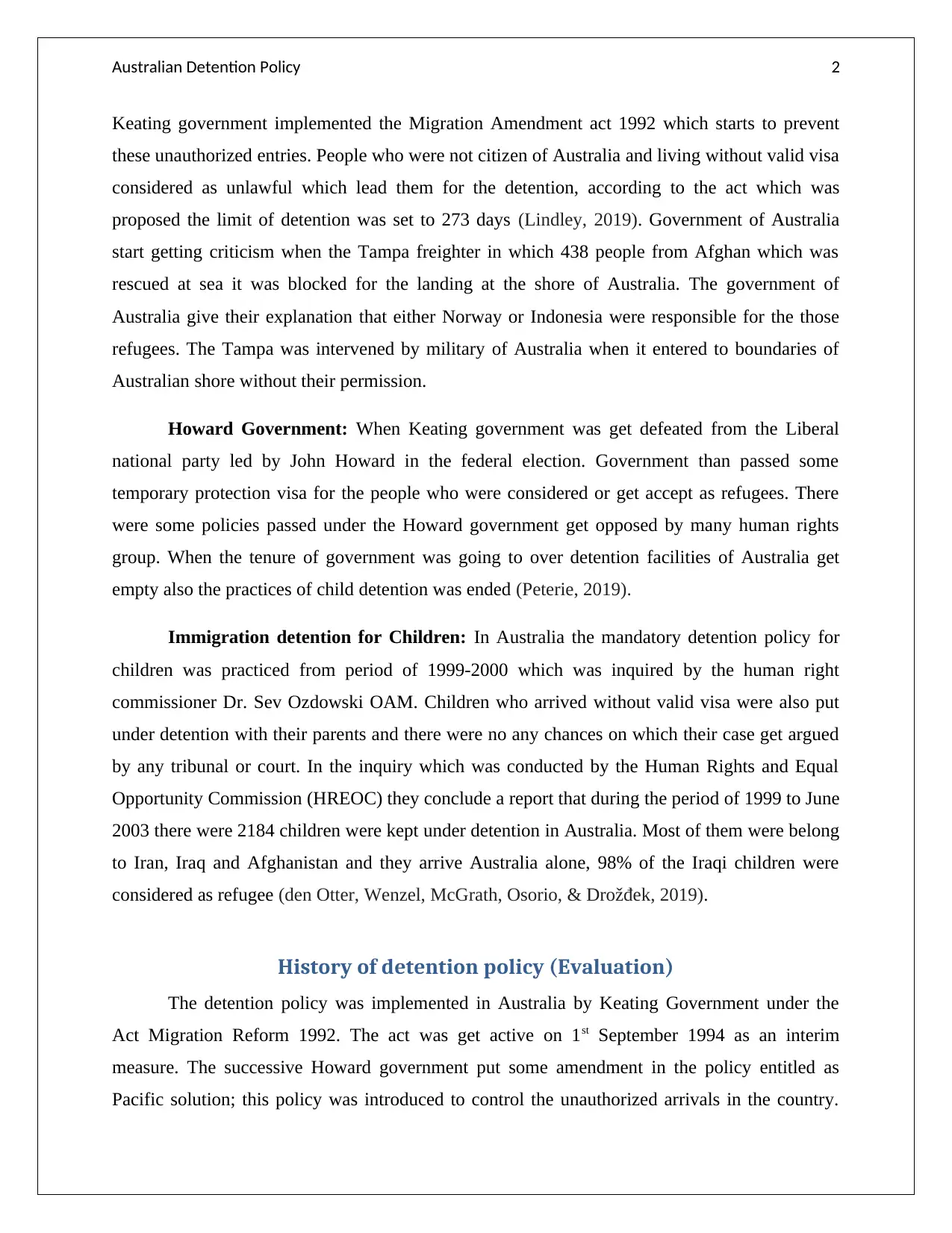
Australian Detention Policy 2
Keating government implemented the Migration Amendment act 1992 which starts to prevent
these unauthorized entries. People who were not citizen of Australia and living without valid visa
considered as unlawful which lead them for the detention, according to the act which was
proposed the limit of detention was set to 273 days (Lindley, 2019). Government of Australia
start getting criticism when the Tampa freighter in which 438 people from Afghan which was
rescued at sea it was blocked for the landing at the shore of Australia. The government of
Australia give their explanation that either Norway or Indonesia were responsible for the those
refugees. The Tampa was intervened by military of Australia when it entered to boundaries of
Australian shore without their permission.
Howard Government: When Keating government was get defeated from the Liberal
national party led by John Howard in the federal election. Government than passed some
temporary protection visa for the people who were considered or get accept as refugees. There
were some policies passed under the Howard government get opposed by many human rights
group. When the tenure of government was going to over detention facilities of Australia get
empty also the practices of child detention was ended (Peterie, 2019).
Immigration detention for Children: In Australia the mandatory detention policy for
children was practiced from period of 1999-2000 which was inquired by the human right
commissioner Dr. Sev Ozdowski OAM. Children who arrived without valid visa were also put
under detention with their parents and there were no any chances on which their case get argued
by any tribunal or court. In the inquiry which was conducted by the Human Rights and Equal
Opportunity Commission (HREOC) they conclude a report that during the period of 1999 to June
2003 there were 2184 children were kept under detention in Australia. Most of them were belong
to Iran, Iraq and Afghanistan and they arrive Australia alone, 98% of the Iraqi children were
considered as refugee (den Otter, Wenzel, McGrath, Osorio, & Drožđek, 2019).
History of detention policy (Evaluation)
The detention policy was implemented in Australia by Keating Government under the
Act Migration Reform 1992. The act was get active on 1st September 1994 as an interim
measure. The successive Howard government put some amendment in the policy entitled as
Pacific solution; this policy was introduced to control the unauthorized arrivals in the country.
Keating government implemented the Migration Amendment act 1992 which starts to prevent
these unauthorized entries. People who were not citizen of Australia and living without valid visa
considered as unlawful which lead them for the detention, according to the act which was
proposed the limit of detention was set to 273 days (Lindley, 2019). Government of Australia
start getting criticism when the Tampa freighter in which 438 people from Afghan which was
rescued at sea it was blocked for the landing at the shore of Australia. The government of
Australia give their explanation that either Norway or Indonesia were responsible for the those
refugees. The Tampa was intervened by military of Australia when it entered to boundaries of
Australian shore without their permission.
Howard Government: When Keating government was get defeated from the Liberal
national party led by John Howard in the federal election. Government than passed some
temporary protection visa for the people who were considered or get accept as refugees. There
were some policies passed under the Howard government get opposed by many human rights
group. When the tenure of government was going to over detention facilities of Australia get
empty also the practices of child detention was ended (Peterie, 2019).
Immigration detention for Children: In Australia the mandatory detention policy for
children was practiced from period of 1999-2000 which was inquired by the human right
commissioner Dr. Sev Ozdowski OAM. Children who arrived without valid visa were also put
under detention with their parents and there were no any chances on which their case get argued
by any tribunal or court. In the inquiry which was conducted by the Human Rights and Equal
Opportunity Commission (HREOC) they conclude a report that during the period of 1999 to June
2003 there were 2184 children were kept under detention in Australia. Most of them were belong
to Iran, Iraq and Afghanistan and they arrive Australia alone, 98% of the Iraqi children were
considered as refugee (den Otter, Wenzel, McGrath, Osorio, & Drožđek, 2019).
History of detention policy (Evaluation)
The detention policy was implemented in Australia by Keating Government under the
Act Migration Reform 1992. The act was get active on 1st September 1994 as an interim
measure. The successive Howard government put some amendment in the policy entitled as
Pacific solution; this policy was introduced to control the unauthorized arrivals in the country.
⊘ This is a preview!⊘
Do you want full access?
Subscribe today to unlock all pages.

Trusted by 1+ million students worldwide
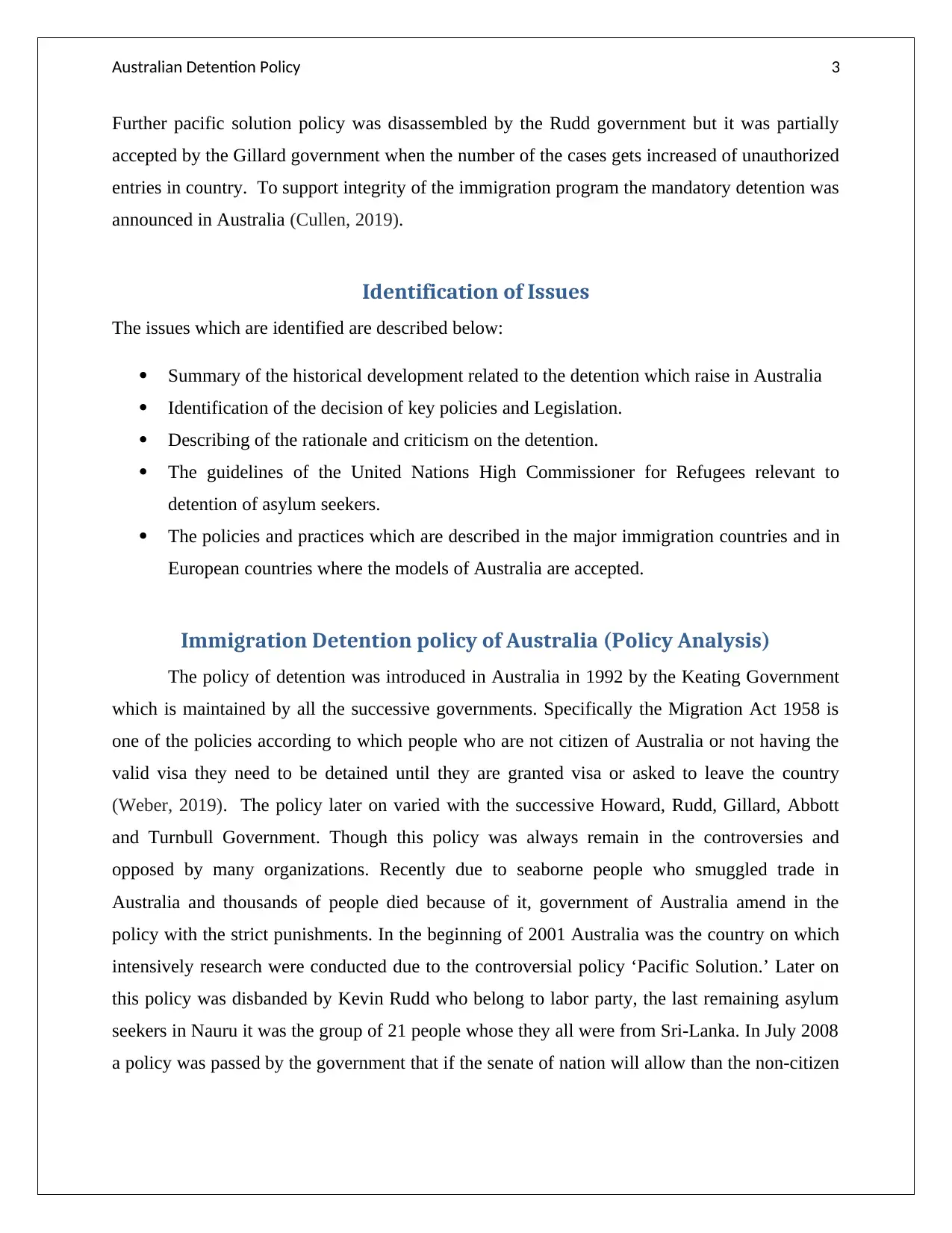
Australian Detention Policy 3
Further pacific solution policy was disassembled by the Rudd government but it was partially
accepted by the Gillard government when the number of the cases gets increased of unauthorized
entries in country. To support integrity of the immigration program the mandatory detention was
announced in Australia (Cullen, 2019).
Identification of Issues
The issues which are identified are described below:
Summary of the historical development related to the detention which raise in Australia
Identification of the decision of key policies and Legislation.
Describing of the rationale and criticism on the detention.
The guidelines of the United Nations High Commissioner for Refugees relevant to
detention of asylum seekers.
The policies and practices which are described in the major immigration countries and in
European countries where the models of Australia are accepted.
Immigration Detention policy of Australia (Policy Analysis)
The policy of detention was introduced in Australia in 1992 by the Keating Government
which is maintained by all the successive governments. Specifically the Migration Act 1958 is
one of the policies according to which people who are not citizen of Australia or not having the
valid visa they need to be detained until they are granted visa or asked to leave the country
(Weber, 2019). The policy later on varied with the successive Howard, Rudd, Gillard, Abbott
and Turnbull Government. Though this policy was always remain in the controversies and
opposed by many organizations. Recently due to seaborne people who smuggled trade in
Australia and thousands of people died because of it, government of Australia amend in the
policy with the strict punishments. In the beginning of 2001 Australia was the country on which
intensively research were conducted due to the controversial policy ‘Pacific Solution.’ Later on
this policy was disbanded by Kevin Rudd who belong to labor party, the last remaining asylum
seekers in Nauru it was the group of 21 people whose they all were from Sri-Lanka. In July 2008
a policy was passed by the government that if the senate of nation will allow than the non-citizen
Further pacific solution policy was disassembled by the Rudd government but it was partially
accepted by the Gillard government when the number of the cases gets increased of unauthorized
entries in country. To support integrity of the immigration program the mandatory detention was
announced in Australia (Cullen, 2019).
Identification of Issues
The issues which are identified are described below:
Summary of the historical development related to the detention which raise in Australia
Identification of the decision of key policies and Legislation.
Describing of the rationale and criticism on the detention.
The guidelines of the United Nations High Commissioner for Refugees relevant to
detention of asylum seekers.
The policies and practices which are described in the major immigration countries and in
European countries where the models of Australia are accepted.
Immigration Detention policy of Australia (Policy Analysis)
The policy of detention was introduced in Australia in 1992 by the Keating Government
which is maintained by all the successive governments. Specifically the Migration Act 1958 is
one of the policies according to which people who are not citizen of Australia or not having the
valid visa they need to be detained until they are granted visa or asked to leave the country
(Weber, 2019). The policy later on varied with the successive Howard, Rudd, Gillard, Abbott
and Turnbull Government. Though this policy was always remain in the controversies and
opposed by many organizations. Recently due to seaborne people who smuggled trade in
Australia and thousands of people died because of it, government of Australia amend in the
policy with the strict punishments. In the beginning of 2001 Australia was the country on which
intensively research were conducted due to the controversial policy ‘Pacific Solution.’ Later on
this policy was disbanded by Kevin Rudd who belong to labor party, the last remaining asylum
seekers in Nauru it was the group of 21 people whose they all were from Sri-Lanka. In July 2008
a policy was passed by the government that if the senate of nation will allow than the non-citizen
Paraphrase This Document
Need a fresh take? Get an instant paraphrase of this document with our AI Paraphraser
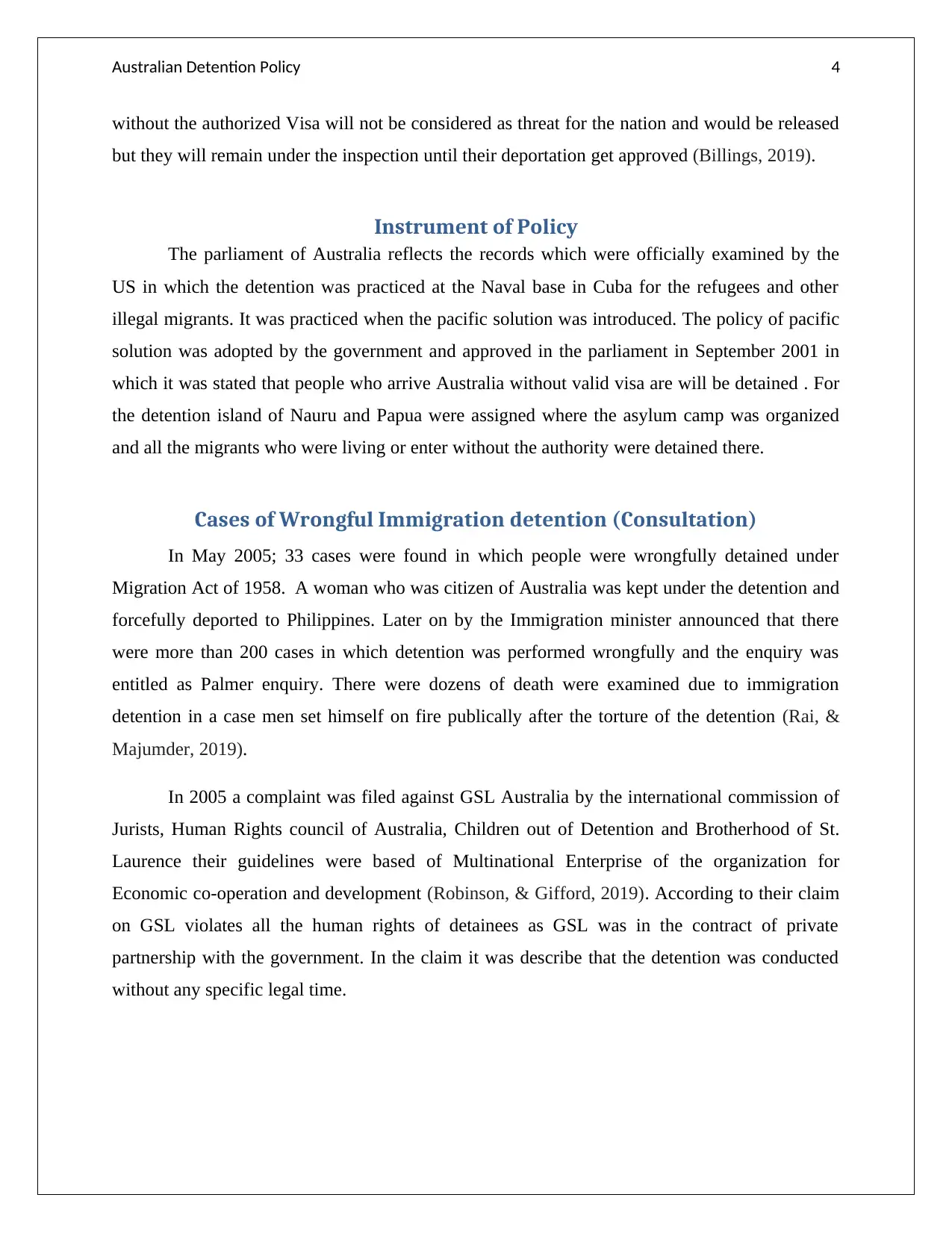
Australian Detention Policy 4
without the authorized Visa will not be considered as threat for the nation and would be released
but they will remain under the inspection until their deportation get approved (Billings, 2019).
Instrument of Policy
The parliament of Australia reflects the records which were officially examined by the
US in which the detention was practiced at the Naval base in Cuba for the refugees and other
illegal migrants. It was practiced when the pacific solution was introduced. The policy of pacific
solution was adopted by the government and approved in the parliament in September 2001 in
which it was stated that people who arrive Australia without valid visa are will be detained . For
the detention island of Nauru and Papua were assigned where the asylum camp was organized
and all the migrants who were living or enter without the authority were detained there.
Cases of Wrongful Immigration detention (Consultation)
In May 2005; 33 cases were found in which people were wrongfully detained under
Migration Act of 1958. A woman who was citizen of Australia was kept under the detention and
forcefully deported to Philippines. Later on by the Immigration minister announced that there
were more than 200 cases in which detention was performed wrongfully and the enquiry was
entitled as Palmer enquiry. There were dozens of death were examined due to immigration
detention in a case men set himself on fire publically after the torture of the detention (Rai, &
Majumder, 2019).
In 2005 a complaint was filed against GSL Australia by the international commission of
Jurists, Human Rights council of Australia, Children out of Detention and Brotherhood of St.
Laurence their guidelines were based of Multinational Enterprise of the organization for
Economic co-operation and development (Robinson, & Gifford, 2019). According to their claim
on GSL violates all the human rights of detainees as GSL was in the contract of private
partnership with the government. In the claim it was describe that the detention was conducted
without any specific legal time.
without the authorized Visa will not be considered as threat for the nation and would be released
but they will remain under the inspection until their deportation get approved (Billings, 2019).
Instrument of Policy
The parliament of Australia reflects the records which were officially examined by the
US in which the detention was practiced at the Naval base in Cuba for the refugees and other
illegal migrants. It was practiced when the pacific solution was introduced. The policy of pacific
solution was adopted by the government and approved in the parliament in September 2001 in
which it was stated that people who arrive Australia without valid visa are will be detained . For
the detention island of Nauru and Papua were assigned where the asylum camp was organized
and all the migrants who were living or enter without the authority were detained there.
Cases of Wrongful Immigration detention (Consultation)
In May 2005; 33 cases were found in which people were wrongfully detained under
Migration Act of 1958. A woman who was citizen of Australia was kept under the detention and
forcefully deported to Philippines. Later on by the Immigration minister announced that there
were more than 200 cases in which detention was performed wrongfully and the enquiry was
entitled as Palmer enquiry. There were dozens of death were examined due to immigration
detention in a case men set himself on fire publically after the torture of the detention (Rai, &
Majumder, 2019).
In 2005 a complaint was filed against GSL Australia by the international commission of
Jurists, Human Rights council of Australia, Children out of Detention and Brotherhood of St.
Laurence their guidelines were based of Multinational Enterprise of the organization for
Economic co-operation and development (Robinson, & Gifford, 2019). According to their claim
on GSL violates all the human rights of detainees as GSL was in the contract of private
partnership with the government. In the claim it was describe that the detention was conducted
without any specific legal time.
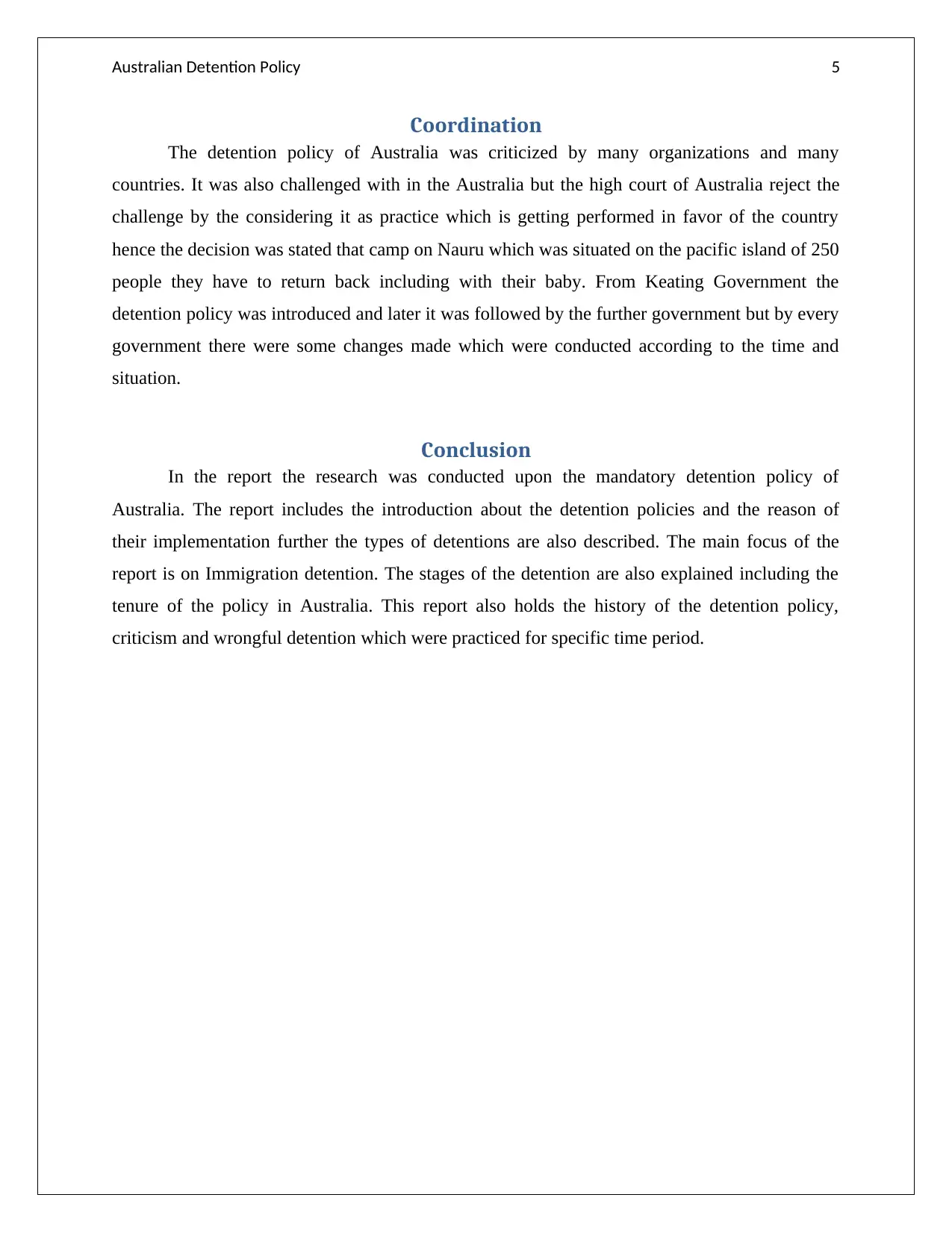
Australian Detention Policy 5
Coordination
The detention policy of Australia was criticized by many organizations and many
countries. It was also challenged with in the Australia but the high court of Australia reject the
challenge by the considering it as practice which is getting performed in favor of the country
hence the decision was stated that camp on Nauru which was situated on the pacific island of 250
people they have to return back including with their baby. From Keating Government the
detention policy was introduced and later it was followed by the further government but by every
government there were some changes made which were conducted according to the time and
situation.
Conclusion
In the report the research was conducted upon the mandatory detention policy of
Australia. The report includes the introduction about the detention policies and the reason of
their implementation further the types of detentions are also described. The main focus of the
report is on Immigration detention. The stages of the detention are also explained including the
tenure of the policy in Australia. This report also holds the history of the detention policy,
criticism and wrongful detention which were practiced for specific time period.
Coordination
The detention policy of Australia was criticized by many organizations and many
countries. It was also challenged with in the Australia but the high court of Australia reject the
challenge by the considering it as practice which is getting performed in favor of the country
hence the decision was stated that camp on Nauru which was situated on the pacific island of 250
people they have to return back including with their baby. From Keating Government the
detention policy was introduced and later it was followed by the further government but by every
government there were some changes made which were conducted according to the time and
situation.
Conclusion
In the report the research was conducted upon the mandatory detention policy of
Australia. The report includes the introduction about the detention policies and the reason of
their implementation further the types of detentions are also described. The main focus of the
report is on Immigration detention. The stages of the detention are also explained including the
tenure of the policy in Australia. This report also holds the history of the detention policy,
criticism and wrongful detention which were practiced for specific time period.
⊘ This is a preview!⊘
Do you want full access?
Subscribe today to unlock all pages.

Trusted by 1+ million students worldwide
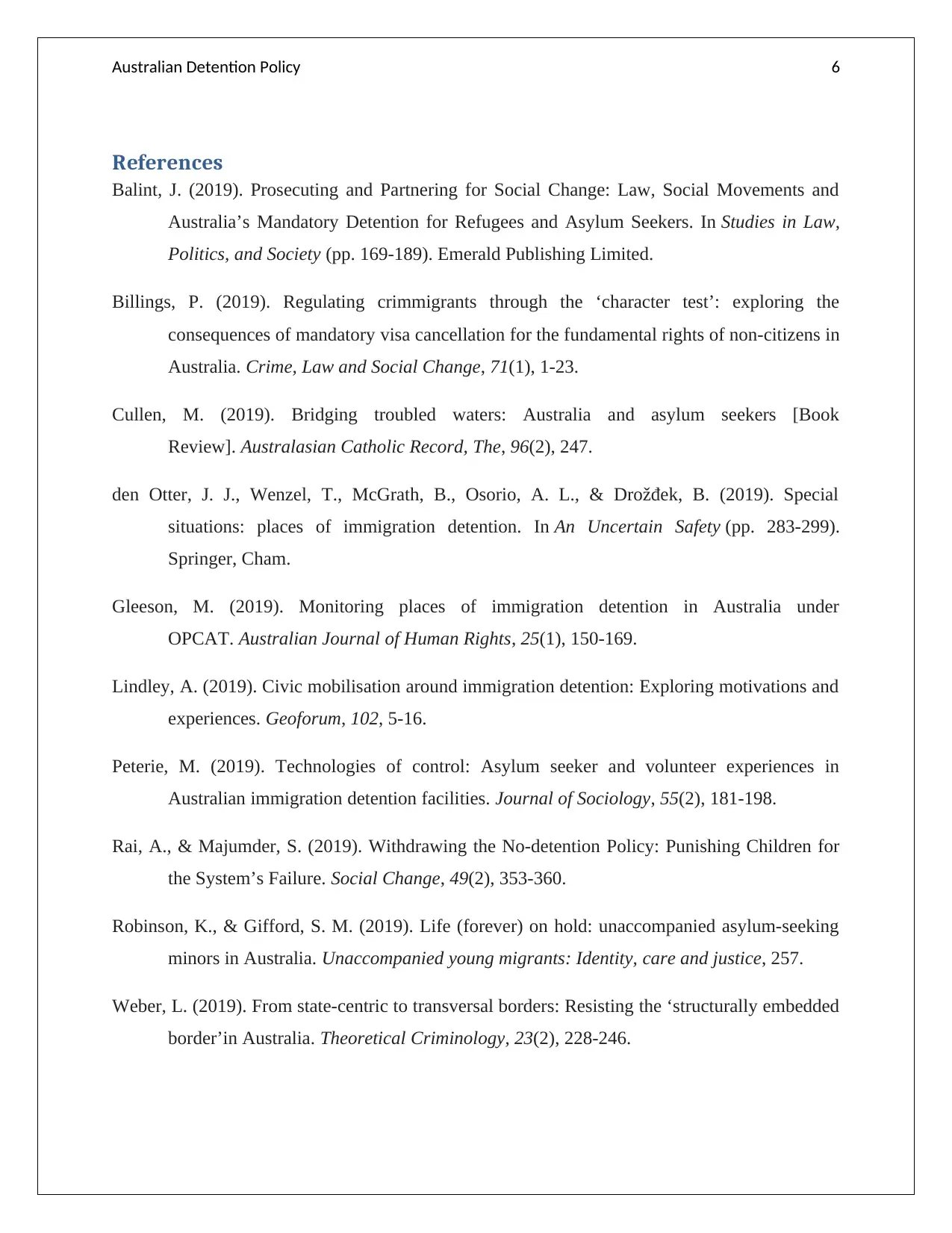
Australian Detention Policy 6
References
Balint, J. (2019). Prosecuting and Partnering for Social Change: Law, Social Movements and
Australia’s Mandatory Detention for Refugees and Asylum Seekers. In Studies in Law,
Politics, and Society (pp. 169-189). Emerald Publishing Limited.
Billings, P. (2019). Regulating crimmigrants through the ‘character test’: exploring the
consequences of mandatory visa cancellation for the fundamental rights of non-citizens in
Australia. Crime, Law and Social Change, 71(1), 1-23.
Cullen, M. (2019). Bridging troubled waters: Australia and asylum seekers [Book
Review]. Australasian Catholic Record, The, 96(2), 247.
den Otter, J. J., Wenzel, T., McGrath, B., Osorio, A. L., & Drožđek, B. (2019). Special
situations: places of immigration detention. In An Uncertain Safety (pp. 283-299).
Springer, Cham.
Gleeson, M. (2019). Monitoring places of immigration detention in Australia under
OPCAT. Australian Journal of Human Rights, 25(1), 150-169.
Lindley, A. (2019). Civic mobilisation around immigration detention: Exploring motivations and
experiences. Geoforum, 102, 5-16.
Peterie, M. (2019). Technologies of control: Asylum seeker and volunteer experiences in
Australian immigration detention facilities. Journal of Sociology, 55(2), 181-198.
Rai, A., & Majumder, S. (2019). Withdrawing the No-detention Policy: Punishing Children for
the System’s Failure. Social Change, 49(2), 353-360.
Robinson, K., & Gifford, S. M. (2019). Life (forever) on hold: unaccompanied asylum-seeking
minors in Australia. Unaccompanied young migrants: Identity, care and justice, 257.
Weber, L. (2019). From state-centric to transversal borders: Resisting the ‘structurally embedded
border’in Australia. Theoretical Criminology, 23(2), 228-246.
References
Balint, J. (2019). Prosecuting and Partnering for Social Change: Law, Social Movements and
Australia’s Mandatory Detention for Refugees and Asylum Seekers. In Studies in Law,
Politics, and Society (pp. 169-189). Emerald Publishing Limited.
Billings, P. (2019). Regulating crimmigrants through the ‘character test’: exploring the
consequences of mandatory visa cancellation for the fundamental rights of non-citizens in
Australia. Crime, Law and Social Change, 71(1), 1-23.
Cullen, M. (2019). Bridging troubled waters: Australia and asylum seekers [Book
Review]. Australasian Catholic Record, The, 96(2), 247.
den Otter, J. J., Wenzel, T., McGrath, B., Osorio, A. L., & Drožđek, B. (2019). Special
situations: places of immigration detention. In An Uncertain Safety (pp. 283-299).
Springer, Cham.
Gleeson, M. (2019). Monitoring places of immigration detention in Australia under
OPCAT. Australian Journal of Human Rights, 25(1), 150-169.
Lindley, A. (2019). Civic mobilisation around immigration detention: Exploring motivations and
experiences. Geoforum, 102, 5-16.
Peterie, M. (2019). Technologies of control: Asylum seeker and volunteer experiences in
Australian immigration detention facilities. Journal of Sociology, 55(2), 181-198.
Rai, A., & Majumder, S. (2019). Withdrawing the No-detention Policy: Punishing Children for
the System’s Failure. Social Change, 49(2), 353-360.
Robinson, K., & Gifford, S. M. (2019). Life (forever) on hold: unaccompanied asylum-seeking
minors in Australia. Unaccompanied young migrants: Identity, care and justice, 257.
Weber, L. (2019). From state-centric to transversal borders: Resisting the ‘structurally embedded
border’in Australia. Theoretical Criminology, 23(2), 228-246.
1 out of 7
Related Documents
Your All-in-One AI-Powered Toolkit for Academic Success.
+13062052269
info@desklib.com
Available 24*7 on WhatsApp / Email
![[object Object]](/_next/static/media/star-bottom.7253800d.svg)
Unlock your academic potential
Copyright © 2020–2025 A2Z Services. All Rights Reserved. Developed and managed by ZUCOL.



